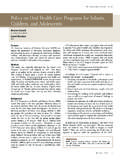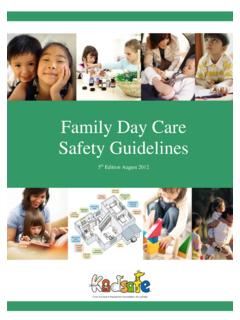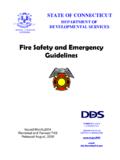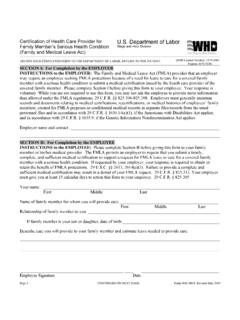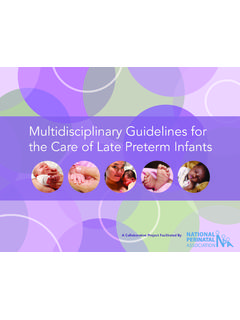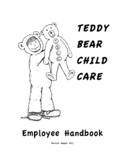Transcription of Policy on Oral Health in Child Care Centers
1 38 oral Health POLICIES38 838OR8 ALHOEHTAAAAPAICASAOoAuAAAAAncASAniPurpos eThe American Academy of Pediatric Dentistry (AAPD) recog-nizes that one out of three preschool age children receives care in a Child care The expectation is that this Policy will provide guidance to the Child care Centers , pediatric dentists, other Health care professionals, legislators, and Policy makers regarding oral Health activities and oral Health promotion in out-of-home Child care This Policy was originally developed by the Council of Clin- ical Affairs and adopted in 2011. This document is an update of the original Policy . The revision is based upon a review of current dental and medical literature, including a search of the PubMed /MEDLINE database using the terms: oral Health care guidelines in Child care Centers , Child daycare Centers and dental Health , dental guidelines and daycare Centers , and dental care in Child day care Centers ; fields: all; limits: within the last 10 years, humans, English, birth through age 18.
2 Twenty- two articles matched these criteria. Papers for review were chosen from this list and from the references within selected articles. When data did not appear sufficient or were incon- clusive, policies were based upon expert and/or consensus opinion by experienced researchers and clinicians. Documents of Health care and public Policy organizations, state statutes, and regulations relating to the concept of oral Health in Child care Centers also were reviewed. Background In the in 2011, 61 percent of children ages zero through five received some form of Child care arrangement on a regular basis from persons other than their Fifty-five to 65 percent of these children attended center -based programs which include day care Centers , pre-kindergartens, nursery schools, Head Start programs, and other early childhood edu- cation ,3 Parents, directors of Child care Centers , and Health profes-sionals believe that enhancing Health promotion education in Child care could improve Child It is important that the oral Health needs of infants and young children be ad- dressed as early as possible and as a part of well- Child care since dental disease is preventable.
3 Currently, a majority of states address oral Health in their Child care licensing However, a majority of states oral Health regulations in early education and Child care center programs do not provide comprehensive oral Health policies and Forty-six states developed nutritional regulations on the frequency of providing snacks and meals at Child care In con- trast, oral Health practices were not well addressed, as demonstrated by limited regulations highlighting prevention of early childhood caries (ECC).6 In one state, there were found to be variations in some oral Health practices between Centers serving children of lower socioeconomic status and those providing care to higher socioeconomic status In comparison of state-funded and non-state-funded Child care Centers , the researcher found non-state-funded Centers were more inclined to implement oral Health A higher percentage of state-funded childcare Centers reported tooth brushing as a routine activity in the classroom.
4 Whereas a higher percentage of non-state funded Centers reported having implemented numerous oral Health practices as well as an educational practice focusing on oral Many organizations have requirements and recommendations that apply to out-of-home Child care . The American Academy of Pediatrics, the American Public Health Association, the National Association for the Education of Young Children (NAEYC), and Head Start are some of the organizations that address oral Health in out-of-home Child They are valuable resources, as are many state publications. Effective oral Health care requires collaboration between families, early care and educational professionals, and Health care professionals. Collaboration has the potential to improve the breadth and effectiveness of Health promotion education4 and enhance the opportunity for a Child to have a lifetime free from preventable oral disease.
5 Establishment of a dental home by 12 months of age ensures awareness of age-specific oral Health issues with long term positive effects for the chil- Caries is a significant public Health problem affecting pre-school It is the most common chronic disease of childhood, affecting 28 percent of children two to five years of age, or over four million children By the time they begin kindergarten, 40 percent of children have Epidemiologic data from a 2011-2012 national survey Review Council Council on Clinical AffairsLatest Revision 2016 Policy on oral Health in Child care CentersABBREVIATIONS AAPD: American Academy Pediatric Dentistry. ECC: Early Child -hood caries. AMERICAN ACADEMY OF PEDIATRIC DENTISTRY oral Health POLICIES 39clearly indicates that ECC remains highly prevalent in poor and near poor preschool The prevalence of caries within the two to five year old age group among higher-income families was 18 percent, while that of children from low-income families was 42 ,17 Low-income children are affected disproportionately.
6 80 percent of tooth decay is found in 20 to 25 percent of children, large portions of whom live in poverty or low income Dental care is the greatest unmet need for Policy statement The AAPD encourages Child care Centers , early education pro- viders, and parents to implement preventive practices that can decrease a Child s risk of developing The AAPD recog-nizes that increasing Health promotion in out-of-home Child care settings could improve the oral Health of millions of pre-school age children. Therefore, the AAPD encourages Child care Centers to: Utilize oral Health consultation, preferably by a pediatric dentist, at least once a year and as needed. The Health consultant should review and observe program practices regarding oral Health and make individualized recom- mendations for each program.
7 Promote the concept of the dental home by educating their personnel as well as the parents on the importance of oral Health and providing assistance with establish- ment of a dental home no later than 12 months of age of the Child . Maintain a dental record, starting at age 12 months with yearly updates, as part of the Child s Health report. It should address the Child s oral Health needs including any special instructions given to the caregivers. Have written, up-to-date, comprehensive procedures to prepare for, report, and respond to medical and dental emergencies. The source of urgent care should be known to caregivers and acceptable to parents. Sponsor on-site, age-appropriate oral Health education programs for the children that will promote good oral hygiene and dietary practices, injury prevention, and the importance of regularly scheduled dental visits.
8 Provide in-service training programs for personnel regard-ing oral hygiene concepts, proper nutrition choices, link between diet and tooth decay, prevention of ECC, and children s oral Health issues including proper initial response to traumatic injuries along with dental conse-quences. Personnel with an understanding of these concepts are at a great advantage in caring for children. Encourage parents to be active partners in their children s Health care process and provide an individualized educa- tion plan, one that is sensitive to cultural values and beliefs, to meet every family s needs. Written material should be available and, at a minimum, address oral Health promotion and disease prevention and the timing of dental visits.
9 Familiarize parents with the use of and rationale for oral Health procedures administered through the program and obtain advance parental authorization for such pro- cedures. Incorporate an oral Health assessment as part of the daily Health check of each Child . Promote supervised or assisted oral hygiene practices at least once daily after a meal or a snack. Provide well-balanced and nutrient-dense diets of low Have clean, optimally-fluoridated drinking water avail- able for consumption throughout the Not permit infants and toddlers to have bottles/sippy cups in the crib or to carry them while walking or crawl- ing while under the Child care center s supervision. Minimize saliva-sharing activities ( , sharing utensils, orally cleansing a pacifier) to help decrease an infant s or toddler s acquisition of cariogenic Consider implementation of comprehensive oral Health practices when legislative regulations are limited or non- 1.
10 Laughlin L. Who s minding the kids? Child care arrange-ments: Spring 2011. Current Population Reports, P70- 135, Census Bureau, Washington, ; 2013. Avail- able at: . Accessed June 15, 2016. 2. The Federal Interagency Forum on Child and Family Sta-tistics (Forum), America s Children in Brief: Key National Indicators of Well-Being 2010. Available at: . Accessed June 15, 2016. 3. Organisation for Economic Co-operation and Develop- ment. Enrolment in childcare and pre-school. Available at: Accessed June 15, 2016. 4. Gupta RS, Shuman S, Taveras EM, Kulldorff M, Finkel- stein JA. Opportunities for Health promotion education in Child care . Pediatrics 2005;116(4):e499-e505. 5. Kranz AM, Rozier RG. oral Health content of early edu- cation and Child care regulations and standards.



